Assessment of Urban Heat Islands in Small- and Mid-Sized Cities in Brazil
Abstract
:1. Introduction
2. Materials and Methods
2.1. Study Areas
2.2. Measuring UHIs in Small- and Mid-Sized Cities
3. Results and Discussion
3.1. UHIs and Synoptic Conditions
3.2. Urban Morphology, Land Cover, and UHI Magnitude
4. Conclusions
Acknowledgments
Author Contributions
Conflicts of Interest
References
- Oke, T.R. Boundary Layer Climates, 2nd ed.; Methuen and Co.: New York, NY, USA, 1987; pp. 262–303. [Google Scholar]
- García, F.F. Manual de Climatologia Aplicada: Clima, Medio Ambiente y Planificación, 1st ed.; Editorial Síntesis: Madrid, España, 1995. [Google Scholar]
- Yow, D.M. Urban heat islands: Observations, impacts and adaptation. Geogr. Compass 2007, 1, 1227–1251. [Google Scholar] [CrossRef]
- Souch, C.; Grimmond, S. Applied climatology: Urban climate. Prog. Phys. Geogr. 2006, 30, 270–279. [Google Scholar] [CrossRef]
- Grimmond, S. Urbanization and global environmental change: Local effects of urban warming. Geogr. J. 2007, 173, 83–88. [Google Scholar] [CrossRef]
- Oke, T.R.; Maxwell, G.B. Urban heat island dynamics in Montreal and Vancouver. Atmos. Environ. 1975, 9, 191–200. [Google Scholar] [CrossRef]
- Graham, E. The urban heat island of Dublin city during the summer months. J. Ir. Geogr. 1993, 26, 45–57. [Google Scholar] [CrossRef]
- Tso, C.P. A survey of urban heat island studies in two tropical cities. Atmos. Environ. 1996, 30, 507–519. [Google Scholar] [CrossRef]
- Kim, Y.; Baik, J. Maximum urban heat island intensity in Seoul. J. Appl. Meteor. 2002, 41, 651–659. [Google Scholar] [CrossRef]
- Hart, M.; Sailor, D.J. Assessing causes in spatial variability in urban heat island magnitude. In Proceedings of the Seventh Symposium on the Urban Environment, San Diego, CA, USA, 10–13 September 2007.
- Coutts, A.M.; Beringer, J.; Tapper, N.J. Impact of increasing urban density on local climate: Spatial and temporal variations in the surface energy balance in Melbourne, Australia. J. Appl. Meteor. Climatol. 2007, 46, 477–493. [Google Scholar] [CrossRef]
- Holt, T.; Pullen, J. Urban canopy modeling of the New York City metropolitan area: A comparison and validation of single- and multilayer parameterizations. Mon. Wea. Rev. 2007, 135, 1906–1930. [Google Scholar] [CrossRef]
- Kopec, R. Further observations of the urban heat island in a small city. Bull. Amer. Meteor. Soc. 1970, 51, 602–606. [Google Scholar] [CrossRef]
- Duckworth, F.S.; Sandberg, J.S. The effect of cities upon horizontal and vertical temperature gradients. Bull. Am. Meteor. Soc. 1954, 35, 198–207. [Google Scholar]
- Hutcheon, R.J.; Johnson, R.H.; Lowry, W.P.; Black, C.H.; Hadley, D. Observations of the urban heat island in a small city. Bull. Am. Meteorol. Soc. 1967, 48, 7–9. [Google Scholar]
- Doyle, D.; Hawkins, T. Assessing a small summer urban heat island in rural south central Pennsylvania. Geogr. Bull. 2008, 49, 65–76. [Google Scholar]
- Roth, M. Urban heat islands. In Handbook of Environmental Fluid Dynamics: Systems, Pollution, Modeling, and Measurements, 1st ed.; Fernando, H.J.S., Ed.; CRC Press/Taylor & Francis Group: Boca Raton, FL, USA, 2012; Volume 2, pp. 143–159. [Google Scholar]
- Amorim, M.C.C.T. Intensidade e forma da ilha de calor urbana em Presidente Prudente/SP. Geosul 2005, 20, 65–82. [Google Scholar]
- Gartland, L. Ilhas de Calor: Como Mitigar Zonas de Calor em Áreas Urbanas; 1st ed.; Oficina de Textos: São Paulo, Brazil, 2010. [Google Scholar]
- Mendonça, F. Clima e Planejamento urbano em Londrina—Proposição metodológica e de intervenção urbana a partir do estudo do campo térmico. In Clima Urbano, 1st ed.; Monteiro, C.A.F., Mendonça, F., Eds.; Editora Contexto: São Paulo, Brasil, 2003; pp. 93–120. [Google Scholar]
- Cidades. IBGE. Available online: http://cidades.ibge.gov.br/v3/cidades/home-cidades (accessed on 23 November 2016).
- Passos, M.M. A Raia Divisória—Geosistema, Paisagem e Eco-História, 1st ed.; EDUEM: Maringá, Brasil, 2006. [Google Scholar]
- Amorim, M.C.C.T. O clima urbano de Presidente Prudente/SP. Ph.D. Thesis, Tese (Doutorado em Geografia) - Faculdade de Filosofia, Letras e Ciências Humanas, Universidade de São Paulo, São Paulo, Brazil, 2000. [Google Scholar]
- Amorim, M.C.C.T.; Dubreuil, V.; Quenol, H.; Sant’Ana Neto, J.L. Características das ilhas de calor em cidades de porte médio: Exemplos de Presidente Prudente (Brasil) e Rennes (França). Confins 2009, 7, 1–16. [Google Scholar] [CrossRef]
- Barrios, N.A.Z.; Sant’anna Neto, J.L. A circulação atmosférica no extremo oeste paulista. Bol. Climatol. 1996, 1, 8–9. [Google Scholar]
- Tarifa, J.R. Análise comparativa da temperatura e umidade na área urbana e rural de São José dos Campos (SP). Geografia 1977, 2, 59–80. [Google Scholar]
- Mendonça, F.A. O clima e o planejamento urbano de cidades de porte médio e pequeno. Proposição metodológica para estudo e sua aplicação à cidade de Londrina/PR. Ph.D. Thesis, Tese (Doutorado em Geografia Física)-Faculdade de Filosofia, Letras e Ciências Humanas, Universidade de São Paulo, São Paulo, Brizil, 1994. [Google Scholar]
- Sant’Anna Neto, J.L. Os Climas das Cidades Brasileiras, 1st ed.; Programa de Pós-Graduação em Geografia da FCT/UNESP: Presidente Prudente, Brasil, 2002. [Google Scholar]
- Dumke, E.M.S. Clima urbano/conforto térmico e condições de vida na cidade—Uma perspectiva a partir do Aglomerado Urbano da Região Metropolitana de Curitiba (AU-RMC). Ph.D. Thesis, Tese de Doutorado-Programa de Doutorado em Meio Ambiente e Desenvolvimento, Universidade Federal do Paraná, Curitiba, 2007. [Google Scholar]
- Dubreuil, V.; Amorim, M.C.C.T.; Froissard, X.; Quenol, H. Métodos e monitoramento da variabilidade espaçotemporal da ilha de calor em cidades de porte médio—Rennes/França e Presidente Prudente/Brasil. In Experimentos em Climatologia Geográfica; 1st ed.; Silva, C.A., Fialho, E.S., Steinke, E.T., Eds.; Editora da UFGD: Dourados, Brasil, 2014; Volume 1, p. 391. [Google Scholar]
- Oke, T.R. City size and the urban heat island. Atmos. Environ. 1973, 7, 769–779. [Google Scholar] [CrossRef]
- Oke, T.R. Initial Guidance to Obtain Representative Meteorological Observations at Urban Sites; IOM Report 81; World Meteorological Organization: Geneva, Switzerland, 2004. [Google Scholar]
- Gomez, A.L.; Garcia, F.F. La isla de calor en Madrid: Avance de un estudio de clima urbano. Estud. Geogr. 1984, 174, 5–34. [Google Scholar]
- Johnson, D.B. Urban modification of diurnal temperature cycles in Birmingham, U.K. J. Climatol. 1985, 5, 221–225. [Google Scholar] [CrossRef]
- Eliasson, I. Intra-urban noctural temperature differences: Multivariate approach. Clim. Res. 1996, 7, 21–30. [Google Scholar] [CrossRef]
- Howard, L. Climate of London Deduced from Meteorological Observations, 3rd ed.; Harvey and Darton: London, UK, 1833. [Google Scholar]
- Myrup, L. A Numerical model of the urban heat island. J. Appl. Meteor. 1969, 8, 908–918. [Google Scholar] [CrossRef]
- Landsberg, H.E. The Urban Climate, 1st ed.; Academic Press: New York, NY, USA, 1981. [Google Scholar]
- Yague, C.; Zurita, E.; Martinez, A. Statistical analysis of the Madrid urban heat island. Atmos. Environ. 1991, 25, 327–332. [Google Scholar] [CrossRef]
- Morris, C.; Simmonds, I.; Plummer, N. Quantification of the influences of wind and cloud on the nocturnal urban heat island of a large city. J. Appl. Meteor. 2001, 40, 169–182. [Google Scholar] [CrossRef]
- Voogt, J.A. Urban Heat Islands: Hotter Cities. Available online: http://www.actionbioscience.org/environment/voogt.html (accessed on 15 July 2016).
- Montavez, J.P.; Rodriguez, A.; Jimenez, J.I. A study of the urban heat island of Granada. Int. J. Climatol. 2000, 20, 899–911. [Google Scholar] [CrossRef]
- Hinkel, K.M.; Nelson, F.E.; Klene, A.E.; Bell, J.H. The urban heat island in winter at Barrow, Alaska. Int. J. Climatol. 2003, 23, 1889–1905. [Google Scholar] [CrossRef]
- Oke, T.R. The distinction between canopy and boundary-layer heat islands. Atmosphere 1976, 14, 268–277. [Google Scholar]
- Stewart, I.D. Redefining the urban heat island. Ph.D. Thesis, The University of British Columbia, Vancouver, BC, Canada, 2011. [Google Scholar]
- Dorigon, L.P. Clima urbano em Paranavaí: Análise do espaço intraurbano. Master’s Thesis, Dissertação (Mestrado em Geografia)-Faculdade de Ciências e Tecnologia de Presidente Prudente, Universidade Estadual Paulista, São Paulo, Brazil, 2015. [Google Scholar]
- Teixeira, D.C.F. O clima urbano de Rancharia (SP). Ph.D. Thesis, Dissertação (Mestrado em Geografia)-Faculdade de Ciências e Tecnologia de Presidente Prudente, Universidade Estadual Paulista, Presidente Prudente, 2015. [Google Scholar]
- Cardoso, R.S.; Amorim, M.C.C.T. Variações espaciais das temperaturas noturnas de Presidente Prudente-SP em episódios de verão. Ra'e Ga 2017. under review. [Google Scholar]
- Unger, J. Heat island intensity with different meteorological conditions in a medium-sized town: Szeged, Hungary. Theor. Appl. Climatol. 1996, 54, 147–151. [Google Scholar] [CrossRef]
- Balkestahl, L.; Monteiro, A.; Góis, J.; Taesler, R.; Quenol, H. The influence of weather types on the urban heat island’s magnitude and patterns at Paranhos (Porto)—A case study from November 2003 to January 2005. In Proceedings of the Sixth International Conference on urban climate, Gothenburg, Sweden, 12–16 June 2006.
- Arnfield, A.J. Two decades of urban climate research: A review of turbulence, exchanges of energy and water, and the urban heat island. Int. J. Climatol. 2003, 23, 1–26. [Google Scholar] [CrossRef]
- Unger, J.; Sümeghy, Z.; Gulyás, Á.; Bottyán, Z.; Mucsi, L. Land-use and meteorological aspects of the urban heat island. Met. Apps. 2001, 8, 189–194. [Google Scholar] [CrossRef]
- Duarte, D.H.S.; Serra, G.G. Padrões de ocupação do solo e microclimas urbanos na região de clima continental tropical brasileira: Correlaçõe e proposta de um indicador. Ambient. Constr. 2003, 3, 7–20. [Google Scholar]
- Ortiz, G.F.; Amorim, M.C.C.T. Ilhas de Calor em Cândido Mota/SP: Algumas Considerações. Formação (Presidente Prudente) 2011, 18, 238–257. [Google Scholar]
- Ugeda Júnior, J.C.; Amorim, M.C.C.T. Estudo do clima urbano de Jales-SP através do transecto móvel. Rev. GeoNorte 2012, 9, 365–377. [Google Scholar]
- Moreira, J.L. O Clima Urbano em Penápolis/SP: Análise da Temperatura e Umidade Intraurbano. Ph.D. Thesis, Dissertação (Mestrado em Geografia)-Faculdade de Ciências e Tecnologia de Presidente Prudente, Universidade Estadual Paulista, São Paulo, Brazil, 2016. [Google Scholar]
- Stewart, I.D.; Oke, T.R. Thermal differentiation of local climate zones using temperature observations from urban and rural field sites. In Proceedings of the Ninth Symposium on Urban Environment, Boulder, CO, USA, 1–6 August 2010.
- Stewart, I.D.; Oke, T.R.; Krayenhoff, E.S. Evaluation of the “local climate zone” scheme using temperature observations and model simulations. Int. J. Climatol. 2014, 34, 1062–1080. [Google Scholar] [CrossRef]
- Lelovics, E.; Gál, T.; Unger, J. Mapping local climate zones with a vector-based GIS method. In Proceedings of the Air and Water Components of the Environment: Conference Dedicated to World Meteorological Day and World Water Day, Cluj-Napoca, Romania, 22–23 March 2013.
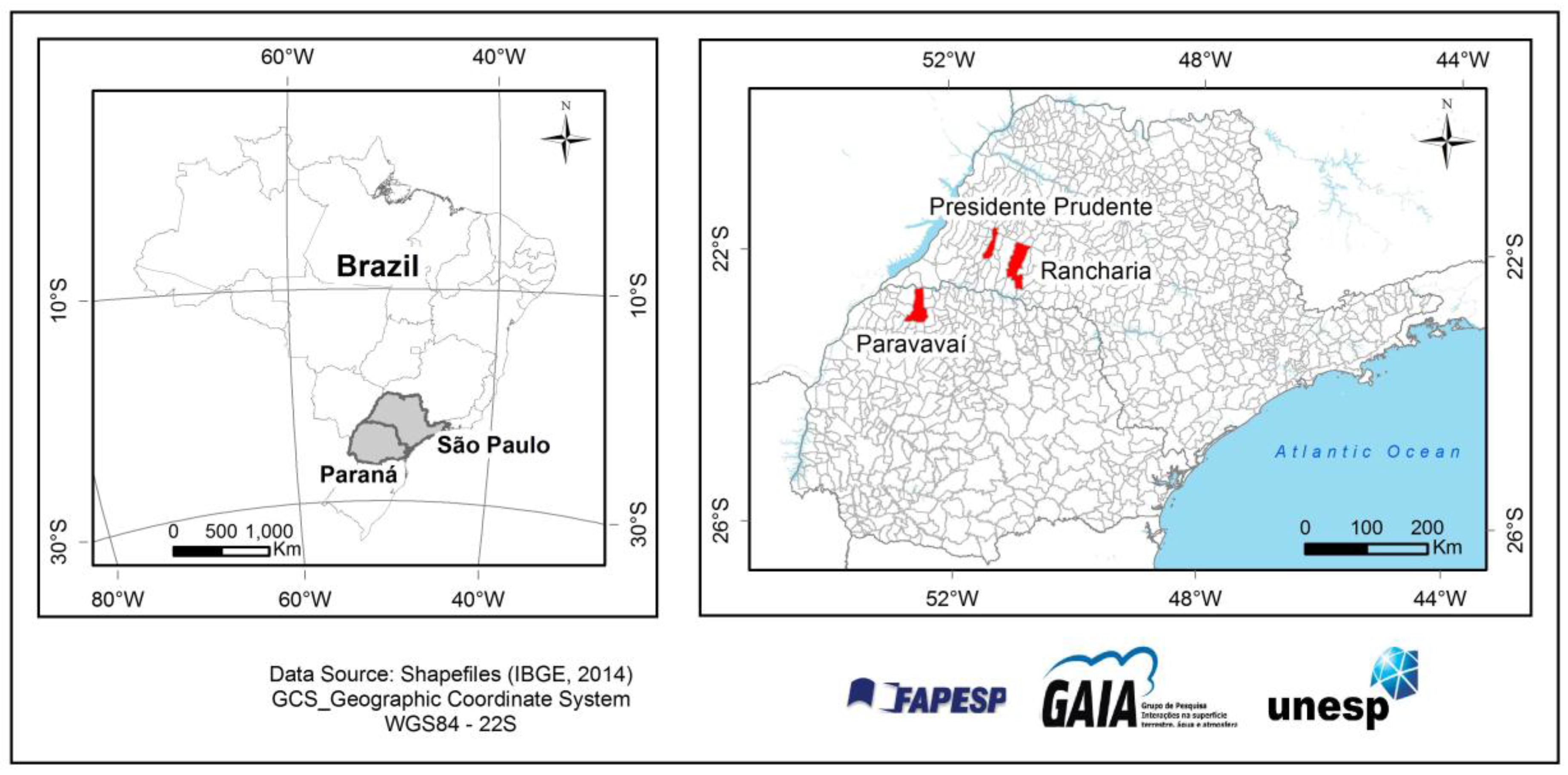
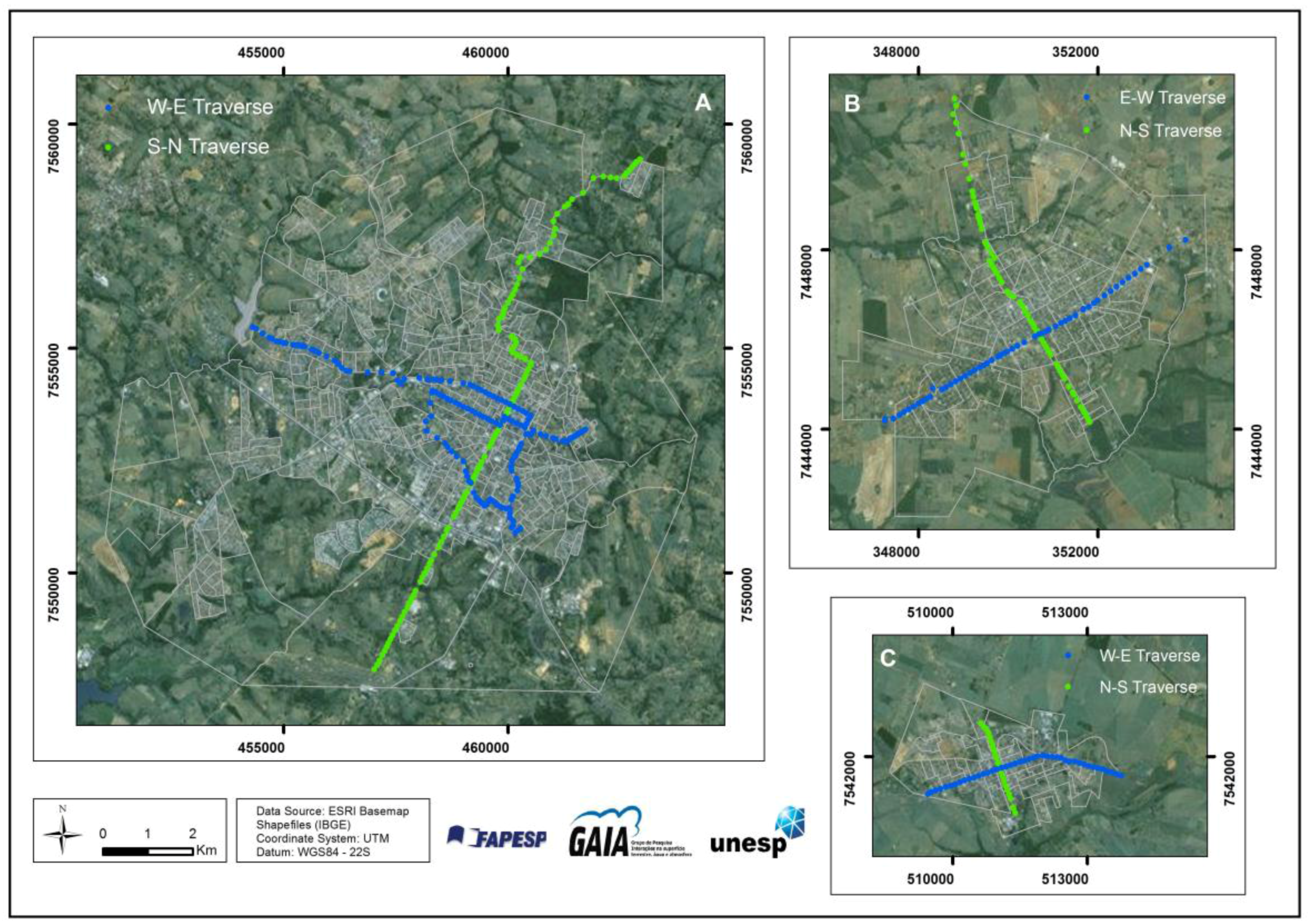
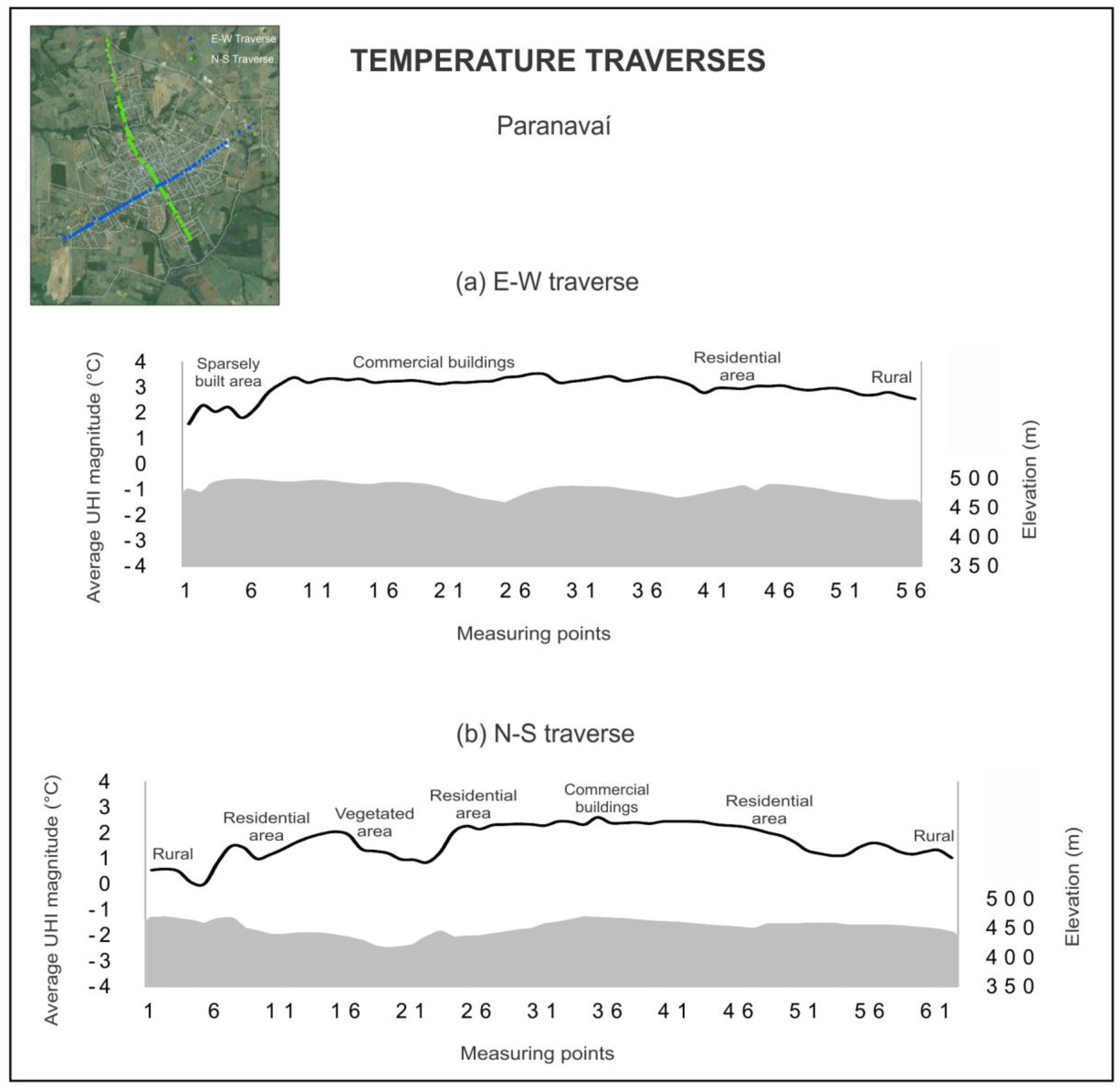
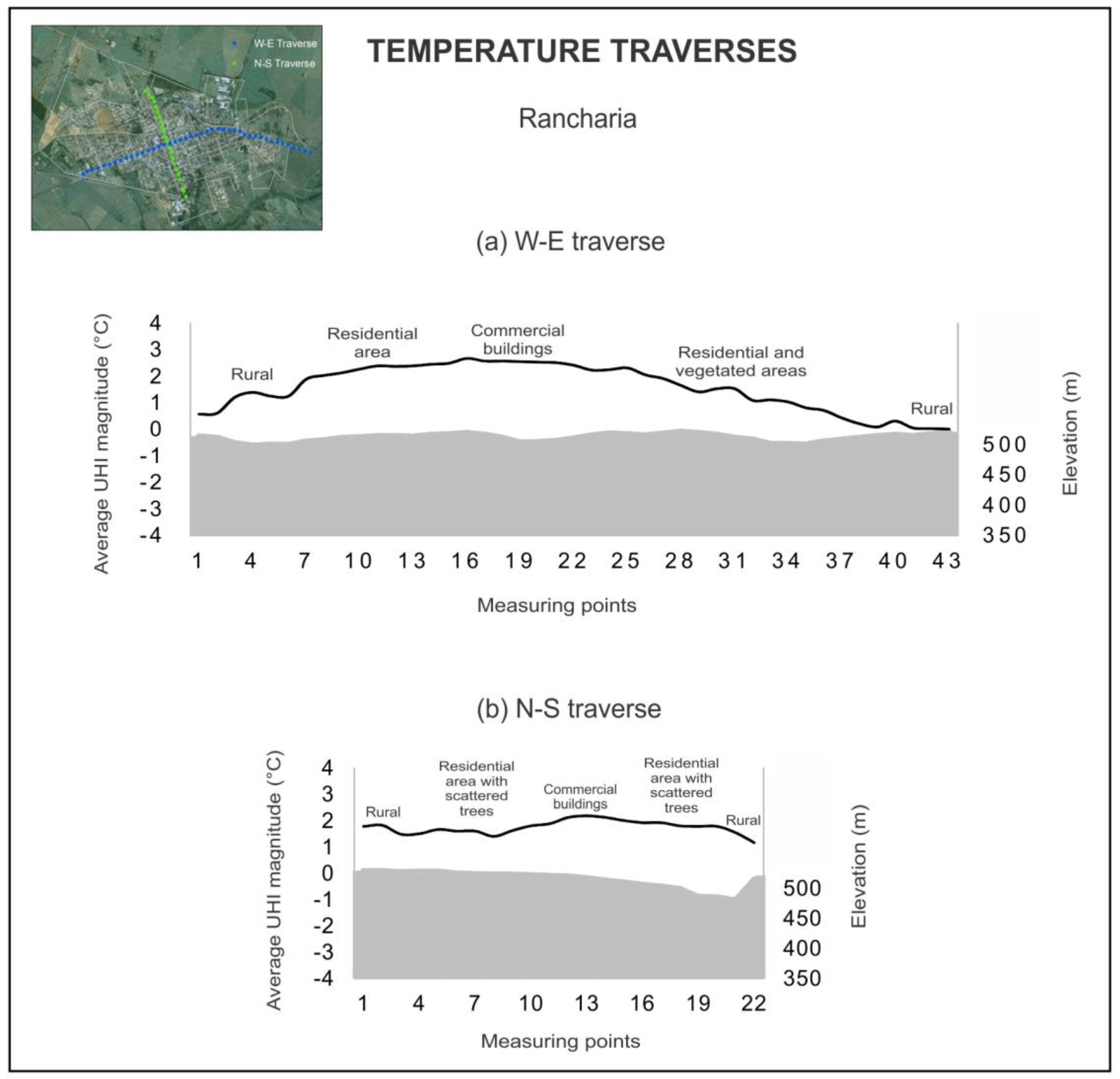
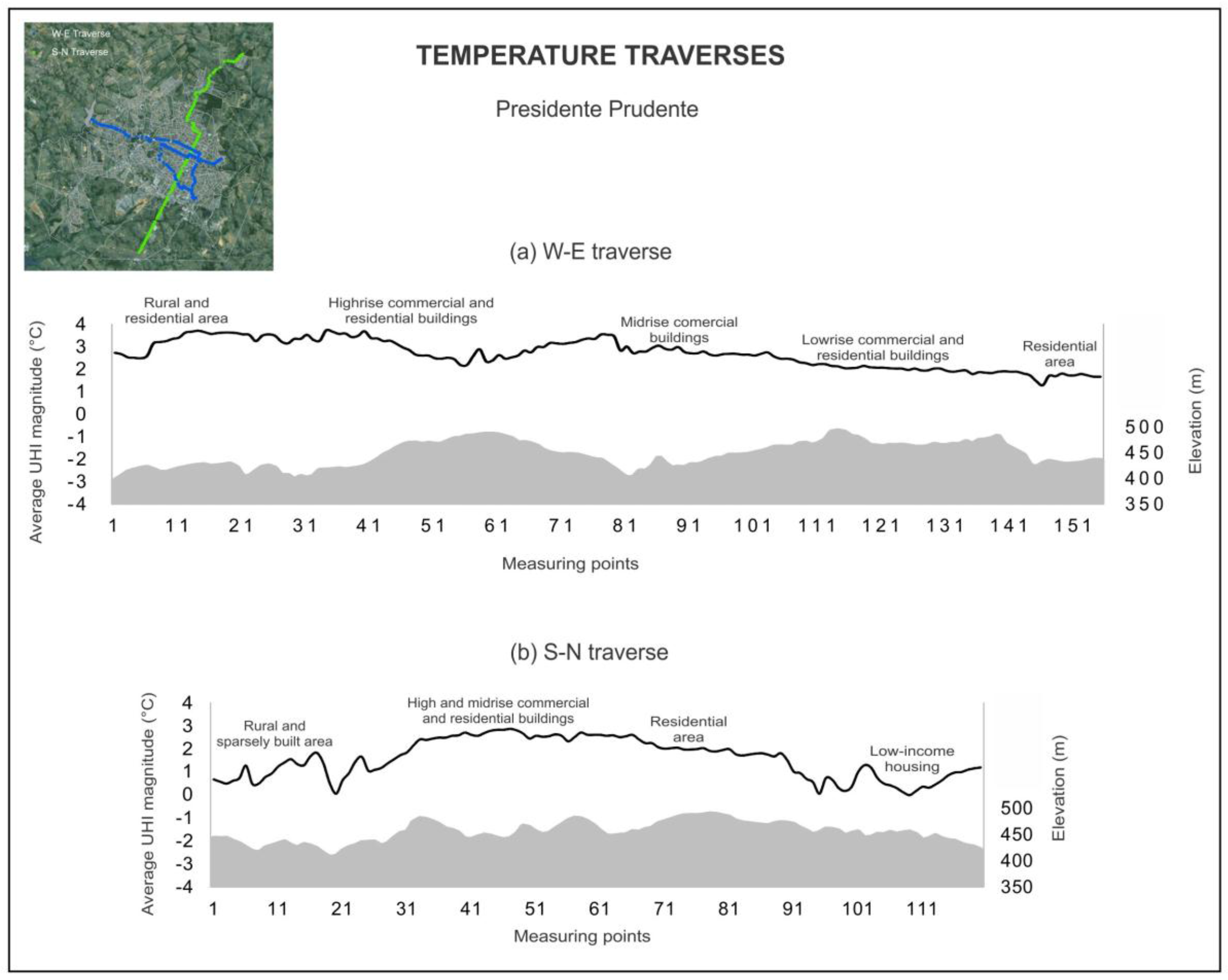
| Date | ∆Tu-r (°C) | Wind Speed (m s−1) | Wind Direction | Atmospheric Systems |
|---|---|---|---|---|
| 11 January 2014 | 4.7 | 1.9 | NE | modified Atlantic Tropical mass (aTm) |
| 12 January 2014 | 3.5 | 1.9 | N | modified Atlantic Tropical mass (aTm) |
| 28 January 2014 | 2.3 | 1.5 | NE | modified Atlantic Tropical mass (aTm) |
| 29 January 2014 | 5.4 | 0.7 | E | modified Atlantic Tropical mass (aTm) |
| 30 January 2014 | 5.5 | 0.6 | S | modified Atlantic Tropical mass (aTm) |
| Date | ∆Tu-r (°C) | Wind Speed (m s−1) | Wind Direction | Atmospheric Systems |
|---|---|---|---|---|
| 5 January 2014 | 2.2 | 2.8 | E | Atlantic Tropical mass (aTm) |
| 9 January 2014 | 2.7 | 0.6 | E | Frontal System (FS) |
| 19 January 2014 | 3.9 | 0.2 | SE | modified Atlantic Polar mass (aPm) |
| 20 January 2014 | 2.9 | 1.7 | E | modified Atlantic Polar mass (aPm) |
| 29 January 2014 | 4.7 | 0.6 | E | Atlantic Tropical mass (aTm) |
| Date | ∆Tu-r (°C) | Wind Speed (m s−1) | Wind Direction | Atmospheric Systems |
|---|---|---|---|---|
| 11 December 2013 | 6 | 1,6 | E | Continental Equatorial mass (cEm) |
| 12 December 2013 | 3.8 | 2,5 | SE | Continental Equatorial mass (cEm) |
| 13 December 2013 | 5.5 | 2,4 | SE | Continental Equatorial mass (cEm) |
| 15 December 2013 | 3.5 | 1,1 | E | Continental Tropical mass (cTm) |
| 16 December 2013 | 5.1 | 0 | - | Continental Tropical mass (cTm) |
© 2017 by the authors. Licensee MDPI, Basel, Switzerland. This article is an open access article distributed under the terms and conditions of the Creative Commons Attribution (CC BY) license ( http://creativecommons.org/licenses/by/4.0/).
Share and Cite
Cardoso, R.D.S.; Dorigon, L.P.; Teixeira, D.C.F.; Amorim, M.C.d.C.T. Assessment of Urban Heat Islands in Small- and Mid-Sized Cities in Brazil. Climate 2017, 5, 14. https://doi.org/10.3390/cli5010014
Cardoso RDS, Dorigon LP, Teixeira DCF, Amorim MCdCT. Assessment of Urban Heat Islands in Small- and Mid-Sized Cities in Brazil. Climate. 2017; 5(1):14. https://doi.org/10.3390/cli5010014
Chicago/Turabian StyleCardoso, Renata Dos Santos, Larissa Piffer Dorigon, Danielle Cardozo Frasca Teixeira, and Margarete Cristiane de Costa Trindade Amorim. 2017. "Assessment of Urban Heat Islands in Small- and Mid-Sized Cities in Brazil" Climate 5, no. 1: 14. https://doi.org/10.3390/cli5010014






